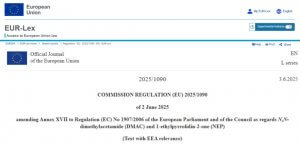EU REACH Annex XVII Adds DMAC and NEP: New Restrictions and Compliance Strategies
Overview
On June 3, 2025, the Official Journal of the European Union published Regulation (EU) 2025/1090, announcing an amendment to Annex XVII of the Regulation (EC) No 1907/2006. The update introduces two new entries, Items 80 and 81, explicitly listing N,N-dimethylacetamide (DMAC) and 1-ethylpyrrolidin-2-one (NEP) in the restricted substances list.
This move aims to further protect workers’ health and reduce risks associated with these two chemicals in industrial applications.
The Regulation shall enter into force on the twentieth day (June 23) following its publication in the Official Journal of the European Union.

Hazard Classification and Risk Assessment of DMAC and NEP
N,N-dimethylacetamide (DMAC) and 1-ethylpyrrolidin-2-one (NEP) are both common dipolar aprotic solvents in industrial settings. Due to their potential occupational exposure health risks, the Netherlands submitted a restriction dossier to the European Chemicals Agency (ECHA). After evaluation, ECHA concluded that unified action at the EU level is necessary to control these risks, beyond existing measures.
| Substances | Main use | Hazard Classification | Risk Assessment Conclusion |
| N,N-dimethylacetamide (DMAC) | Solvent, production of man-made fibres and films, varnishes used for electrical wire insulation, etc | Repr. 1B (developmental toxicity);
Acute Tox. 4 |
The current occupational exposure limit (36 mg/m³) is too high; Long-term DNEL must be controlled at 13 mg/m³ (inhalation) and 1.8 mg/kg bw/day (dermal) |
| 1-ethylpyrrolidin-2-one (NEP) | Solvent, cleaning agents, binder, release
agent, oil field drilling, polymer Processing, etc |
Repr. 1B (developmental toxicity) | Long-term DNEL must be reduced to 4.0 mg/m³ (inhalation) and 2.4 mg/kg bw/day (dermal) |
Key Provisions for DMAC and NEP Entries
| 80. N,N-dimethylacetamide (DMAC)
CAS No 127-19-5
EC No 204-826-4 |
1. Shall not be placed on the market as a substance on its own, as a constituent of other substances, or in mixtures in a concentration equal to or greater than 0,3 % after 23 December 2026 unless manufacturers, importers and downstream users have included in the relevant chemical safety reports and safety data sheets, derived no-effect levels (DNELs) relating to exposure of workers of 13 mg/m3 for long-term exposure by inhalation and 1,8 mg/kg bw/day for long-term dermal exposure.
2. Shall not be manufactured, or used, as a substance on its own, as a constituent of other substances, or in mixtures in a concentration equal to or greater than 0,3 % after 23 December 2026 unless manufacturers and downstream users take the appropriate risk management measures and provide the appropriate operational conditions to ensure that exposure of workers is below the DNELs specified in paragraph 1.
3. By way of derogation from paragraphs 1 and 2, the obligations laid down therein shall apply from 23 June 2029 in relation to placing on the market for use, or use, as a solvent in the production of man-made fibres. |
| 81. 1-ethylpyrrolidin-2-one (NEP)
CAS No 2687-91-4
EC No 220-250-6 |
1. Shall not be placed on the market as a substance on its own, as a constituent of other substances, or in mixtures in a concentration equal to or greater than 0,3 % after 23 December 2026 unless manufacturers, importers and downstream users have included in the relevant chemical safety reports and safety data sheets, derived no-effect levels (DNELs) relating to exposure of workers of 4,0 mg/m3 for long-term exposure by inhalation and 2,4 mg/kg bw/day for long-term dermal exposure.
2. Shall not be manufactured, or used, as a substance on its own, as a constituent of other substances, or in mixtures in a concentration equal to or greater than 0,3 % after 23 December 2026 unless manufacturers and downstream users take the appropriate risk management measures and provide the appropriate operational conditions to ensure that exposure of workers is below the DNELs specified in paragraph 1.’ |
How to Stay Compliant with the New Restrictions
To address these regulatory changes, ensure compliance in the EU market, and safeguard worker health, REACH24H Consulting Group recommends that relevant chemical enterprises take the following measures:
Compliance Preparation
- Screen products to determine if they contain DMAC or NEP, and verify whether their concentrations meet the 0.3% restriction threshold.
- For affected products, update Safety Data Sheets (SDS) and Chemical Safety Reports (CSR) in accordance with the regulation’s timelines, incorporating the new DNELs.
Exposure Control
- Evaluate existing production processes and introduce engineering control measures (e.g., local exhaust ventilation systems) or personal protective equipment (PPE) to ensure worker exposure complies with the limits.
- For man-made fiber manufacturers: Utilize the transition period to upgrade equipment, prioritizing the mitigation of inhalation exposure risks.
Supply Chain Communication and Alternative Assessment
- Notify downstream users of the restriction clauses to ensure full-chain compliance.
- Assess the feasibility of adopting safer alternative substances or processes to reduce reliance on DMAC and NEP.
Monitoring and Documentation
- Regularly monitor workplace exposure levels and retain compliance documentation for inspections.


